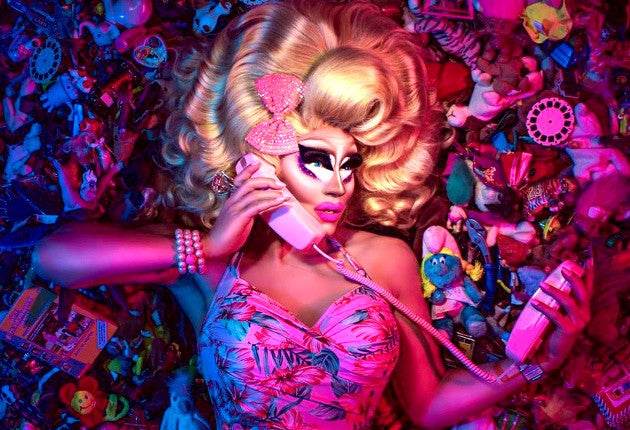
Trixie Mattel is unmistakable, singular in her makeup and appearance.
She’s pushing the boundaries of drag, yes, but remarkably, she isn’t breaking any rules. There are no rules. It’s an art form defined by its traditions: wigs, makeup, dresses–but only sometimes. Take one of those things away, and it’s still drag.
So, what exactly is drag? Trixie posed this question when we spoke. She asked what the difference is between her and The Real Housewives of Atlanta, and I still don’t have a good answer.
Talking to her, you see the incisive and cerebral mind behind Trixie Mattel’s iconic makeup. In our interview, she discusses the homogenizing of drag culture, women who do drag, and why she wants you to think of Barbie when you look at her.
JM: Your makeup makes you instantly recognizable. No one’s ever going to confused you with anyone else.
TM: I always say that drag queens are like an exaggeration of women and I’m like an exaggeration of drag queens. People ask, “Why do you do your makeup so differently” and I always say, “Well, in a subversive art form, ask yourself why so many drag queens do their makeup exactly the same.” If you can do anything, why does everybody do the same thing?
And drag, now that it’s become homogenized, the world has seen it. Now that it’s not so underground, it starts to be a snake that eats its own tail. Drag Race even references Drag Race. It’s a strange art form that I think is in danger of becoming too self-referential at times.
JM: With the homogenizing of drag culture, is that something that drag queens talk and are worried about?
TM: Well, it’s something we notice. When you’re in the culture, you notice that new drag queens will kind of do a cut and paste job of drag queens they’ve seen from TV to create their persona. I don’t think it’s always the most creative approach in an art form where you can truly do whatever you want.
JM: But with it going more mainstream, that also creates more work for you and, as a result, more money.
TM: Definitely. My bank account is very happy that it’s gone mainstream.
As a business person, gay people are 10 percent of the population. If you’re trying to make money off that percentage of the human race, how will you survive? With Drag Race and drag becoming more for everyone, it’s been great. Now instead of making $40 on a Monday night, I can make $45 on a Tuesday night.
JM: I also don’t know that there’s anyway to stop it from continuing to go mainstream.
TM: No. It’s interesting because…what is drag? You can’t tell me that The Real Housewives of Atlanta are not in drag. You can’t tell me that Dolly Parton isn’t in drag. Straight people without realizing it, they’re seeing drag all the time and now they’re just having it labeled as drag. It’s more digestible than you think it is. It’s not an art form that’s just for gay people or just for adults.
JM: I also see in a lot more drag shows that have women performing in drag.
TM: Totally. Some of my favorite drag queens are women. Something that I love about drag is that it’s a celebration of feminity. Trixie Mattel should make you happy when you see the pink and the frills and the glitter and how girly it can be, but it should also make you feel silly for looking at me and thinking it’s a woman.
Drag queens always base their personas on their favorite female icons. Mine was Barbie, who’s not necessarily a human, but is as iconic and beautiful as any woman. I started really pushing it because I hit a crossroads of, “I don’t want to look like a woman or a man. I want to look like a wind-up toy, a plaything manufactured in a factory.”
Looking like a Barbie is something audiences can feel comfortable with. Who doesn’t love Barbie? They feel comforted because it reminds them of how they felt with a little plastic doll in their hands as a kid. So, going darker places with comedy, the audience is more comfortable following me on that journey.
JM: How has doing drag changed your experience of your own masculinity?
TM: There’s something about dressing up as someone else that makes you even more comfortable and happy to put your own clothes back on. It makes me more happy to be a man. I get to go get all my frilliness out of my system and then I’m so excited to go put on boots and jeans and to, you know, not put on glitter. I mean, I’m so gay. I love gay things so much, but I love keeping it separate.
